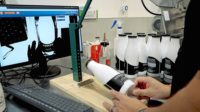Quality organizations will be the front line in adopting artificial intelligence (AI) in electronics manufacturing organizations. Quality leaders and engineers own challenges that impact the business’s throughput and product margins – and those challenges are often well-defined and great use cases for AI.
Today, quality leaders implement quality control (QC) processes with functional tests, visual inspection, and reliability or strife testing. For visual inspection, the latest technology advancements are very old news. Machine vision cameras have been around for decades. Camera sensors have improved resolution. X-rays and CT scans have become more cost-effective, expanding their viable application. But there’s not been anything new for quite a long time. AI has already changed that.
In visual quality control (VQC) today, quality leaders are stuck with options that have significant flaws and do not scale: human inspectors and machine vision cameras. Humans make mistakes at high rates, leading to significant quantities of escapes that can cause downstream yield fallout or field failures. Machine vision cameras are only useful in a few inspection paradigms (but not all) and are challenging to set up, maintain, and scale – particularly in applications with multiple SKUs or lines. As a result, VQC requires significant management from the quality function and is likely always a source of business pain, impacting costs, throughput, and product margins.
With the rise of AI and the global restructuring of where manufactured goods are made, leaders must devise a new strategy for VQC – for the next five to ten years. Many quality leaders will point to AI as being critical in those strategies. Their top-of-mind concerns are building trust in the technology, making it scaleable, and avoiding the pitfalls.
Opportunities for AI in Visual Quality Control
QC processes use data from various testing – functional performance, visual inspection, and reliability – to judge units. AI provides opportunities to get more from these existing datasets on their own, in combination with each other, or with additional datasets like supplier and part configuration information.
In VQC, the most straightforward applications of AI technology are to get more value from the imagery itself. Machine learning algorithms can increase the number of paradigms where machine vision performs well – including new issue discovery, judgment for cable routing and amorphous materials like glue, encapsulants, and paints, as well as judgment for cosmetics inspections. With first-generation AI visual inspection, it is already possible to get superhuman results in escape reduction, novel issue discovery, speed, and overall cost. New second-generation systems have improved detection and precision performance and work for more advanced paradigms.
Beyond the improvement of VQC itself, AI systems can also extract additional value, predictive insights, and new intellectual property by analyzing multi-modal datasets that are not possible to analyze with conventional statistics. For example, while it’s possible to look for correlations between one functional performance metric and another, a data correlation, AI makes it possible to find a visual correlation between a functional performance metric and a part of an image. This is game-changing for accelerating root cause analysis – AI can identify correlating assembly variations for your pile of poorly performing antennas in seconds, significantly compressing the time it takes to solve a manufacturing issue.
Building Trust in AI with Proof of Value
Building organizational trust in the system is one of the most challenging hurdles to overcome in adopting AI technologies anywhere in a business. Quality leaders are incredibly well-positioned to be on the front line for adoption: they have problems that impact the business performance and applications that provide ample opportunities for Proof of Value (POV). VQC is a great place to start.
Organizational trust is earned by demonstrating that the technology works technically, such as in a proof of concept (POC), and by moving the needle on a valuable business KPI. The best way to do this is to upgrade a POC into a Proof of Value (POV). A POV demonstrates how a technology can impact a core business metric and how significant that impact can be. For example, if you are devising a future VQC strategy that incorporates putting image data and AI tools in the hands of your engineers to accelerate the failure analysis process – then you would measure how much faster and efficient that process is with the technology. As a result, a POV must take place “where it hurts” in the manufacturing process to provide an opportunity to prove business value – making them more difficult to execute than POCs. On the other hand, a well-executed POV wins the team’s confidence that uses the technology, as well as the leadership involved in funding the investment needed to roll it out.
Avoiding Pitfalls for AI in Quality Control
A key part of building any strategy is thinking through the challenges or pitfalls and how to avoid them. We can take learnings from first-generation AI systems for VQC to identify critical areas to consider as part of the strategy.
Automate data collection. AI systems improve with more data – and manually uploading it cannot be the final implementation without losing significant value. Automating data collection and processing creates the opportunity for real-time judgment or process impact that can enhance the ability of AI technology to deliver value.
Streamline AI model training. AI must be trained, and some algorithms are very sensitive to variations between trainers. Consider technologies and systems with streamlined algorithm training processes, easy and quick labeling, and where multiple people can provide training feedback without impacting algorithm performance. Ideally, the actual programmers of the algorithms can be the people who will be using the feedback from the system directly – quality engineers and operators – which requires a thoughtful user interface and approach. It won’t be scaleable if you rely on data scientists or software engineers to train models.
Fast evaluation for new models. Speed of response and issue closure are two core selling points of AI applications for VQC and QC. Understand how to integrate your AI system and design your team and processes to maximize these advantages. Can the AI discover new issues? How quickly can you put a validated model live on the line to catch that issue in the future? You want the answers to be fast – on the order of minutes and hours, not days or weeks.
Under-estimating the cost of “Build” in Build vs Buy. While any digital transformation effort should be collaborative and may include teams outside of quality like IT, beware of IT or data engineers on the team saying they can build what you need quickly. These systems are complex and take tens of engineers to develop and maintain – I know this first-hand. Building in-house is a real investment of time, people, and money. Buying the technology is often lower cost and can deliver business results faster.
Take a Step Forward Today
Quality leaders will be a driving force in adopting AI in manufacturing. They will identify key applications that have an impact on business metrics. They will design the first POVs that enable organizations and senior leadership to build trust and confidence in new technology and transformation. And they will lead the cultural shift and design of the infrastructure, process, and people around scaling and extracting value from the technology. What will your VQC strategy be in 5 years? How will you take advantage of AI technology?



